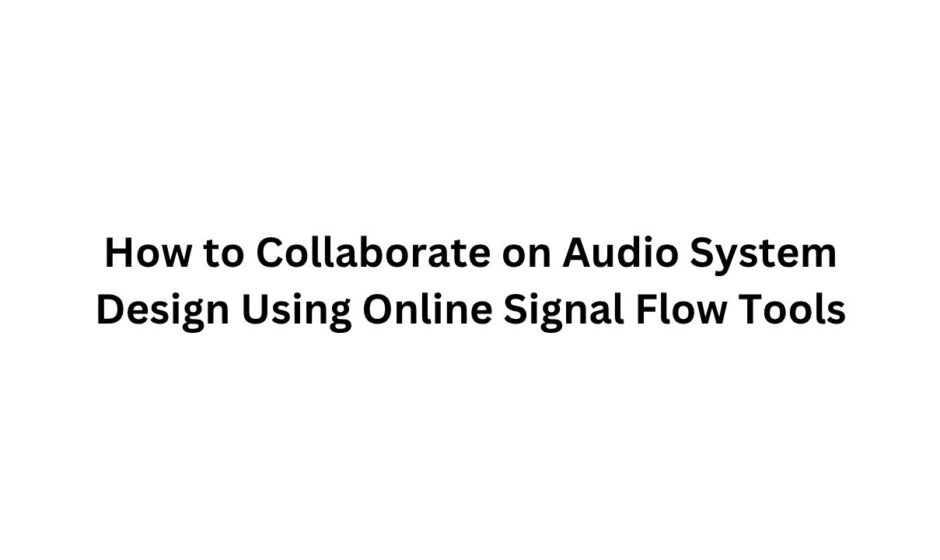Audio system design has always been a collaborative effort—sound engineers, AV integrators, system designers, IT teams, and clients must all work in harmony to bring a system from concept to completion. But in a hybrid, fast-paced, and globally connected world, traditional workflows are no longer enough.
Whiteboards, hand-sketched diagrams, and email chains are being replaced by smart, interactive platforms where multiple collaborators can contribute to, review, and finalize complex AV systems—remotely and in real time.
This shift is especially crucial in designing audio signal flow diagrams, the backbone of any structured AV setup. From a basic studio rack to a full-scale enterprise conferencing solution, clear signal mapping is essential—and now, online audio signal flow diagram software makes that collaboration easier, smarter, and faster.
Why Signal Flow Collaboration Matters
Before we jump into tools and techniques, it’s important to understand why collaborative signal flow diagramming is necessary.
1. AV Projects Are Complex and Multi-Stakeholder
Audio systems often involve:
-
Engineers planning the physical setup
-
Designers mapping DSP logic
-
IT teams managing networking
-
Electricians coordinating cable routing
-
Clients approving budgets and user experience
With this many moving parts, having a centralized, accessible visual plan ensures everyone stays on the same page.
2. Remote Teams Are the New Norm
From design consultants in one city to integrators on-site elsewhere, remote teamwork is now standard. Without an online collaboration platform, projects risk miscommunication, delays, and costly mistakes.
3. Signal Flow Is the Language of Clarity
An audio signal flow diagram is the shared blueprint that makes abstract AV concepts concrete. It breaks through technical barriers and ensures that:
-
Signal paths are clear
-
Hardware responsibilities are defined
-
Troubleshooting is efficient
-
All collaborators can visually verify system logic
What Is Audio Signal Flow Diagram Software?
Audio signal flow diagram software allows users to create visual maps of how audio signals move through various devices in a system. These tools enable:
-
Block diagrams of equipment
-
Cable connections (input/output, analog/digital)
-
Signal direction and types (e.g., Dante, AES/EBU, analog)
-
Port-level precision
-
Layered zones (e.g., stage, rack, FOH)
The best software is cloud-based, meaning multiple users can access, edit, and comment on diagrams simultaneously, no matter where they’re located.
Key Features for Collaborative Design
When choosing an online tool for collaborative audio system design, look for:
| Feature | Why It Matters |
|---|---|
| Cloud Access | Allows distributed teams to work on the same diagram |
| Real-Time Editing | Supports simultaneous multi-user collaboration |
| Version Control | Tracks who made what changes and when |
| Device Libraries | Speeds up design with prebuilt, accurate hardware blocks |
| Port Mapping | Ensures accurate signal routing down to connectors |
| Commenting Tools | Makes feedback and questions easy to manage |
| Export Options | Allows sharing in PDF, PNG, or editable formats |
| Integration | Works with BOMs, wiring schedules, or CAD/BIM workflows |
Top Online Tools for Audio Signal Flow Collaboration
Here are the most powerful platforms to explore:
1. XTEN-AV
-
AI-powered AV design software
-
Real-time collaboration with device libraries
-
Auto-generated signal flow based on actual gear
-
Cloud access with commenting and documentation tools
-
Built-in BOM, rack layout, and DSP signal flow
Best for: Professional AV teams, system integrators, and consultants
2. Lucidchart (Free & Pro Versions)
-
Cloud-based diagramming platform
-
Easy sharing and embedding
-
Custom shape libraries for AV gear
-
Integration with Google Workspace and Microsoft 365
Best for: Freelancers, educators, and small AV teams
3. diagrams.net (formerly Draw.io)
-
Free and open-source
-
Can be hosted locally or used in cloud
-
Simple shape and connection tools
-
Supports team editing via Google Drive or OneDrive
Best for: Budget-conscious teams and quick concept mockups
4. System Surveyor
-
Built for AV, security, and IT design
-
Includes camera, mic, speaker, display libraries
-
Geolocation mapping
-
Collaboration via mobile app and web interface
Best for: Field techs and on-site designers
How to Collaborate on Audio Diagrams Step by Step
Here’s a complete process for using audio signal flow diagram software collaboratively.
Step 1: Set a Clear Goal and Scope
Before starting a diagram, define:
-
System type (live, studio, corporate, broadcast)
-
Total zones or rooms
-
Input/output count
-
Types of signals used (analog, digital, networked)
-
Who needs to be involved in each design phase
Example:
“Design a hybrid conference room audio system with 6 mics, DSP processing, ceiling speakers, and VoIP integration across two rooms.”
Step 2: Choose Your Diagram Platform
-
For professional teams, use XTEN-AV
-
For low-fidelity, choose Lucidchart or diagrams.net
Set up user permissions for each collaborator:
-
Viewer (Client, Approver)
-
Editor (Engineer, Designer)
-
Admin (Project Manager)
Step 3: Add Devices and Connections
Add all key devices:
-
Mics
-
Interfaces or DSPs
-
Mixers
-
Amplifiers
-
Loudspeakers
-
Codecs or PCs
Use the software’s library or custom blocks. XTEN-AV, for example, lets you search by manufacturer and model, then auto-generates I/O ports and labels.
Step 4: Map Out Signal Paths
Using lines and arrows:
-
Show each device connection
-
Indicate signal flow direction
-
Label cable types (XLR, CAT6, HDMI, etc.)
-
Color-code signal types (blue = analog, red = digital)
Step 5: Invite Collaborators to Review
Use the platform’s sharing function to invite stakeholders. Assign each person:
-
Review Role: AV engineer checks signal logic
-
Approval Role: IT verifies IP-based audio streams
-
Installer Role: Confirms cabling and rack mounting
-
Client Role: Reviews user interaction design
Step 6: Leave Comments and Notes
Good diagram tools include comment threads, sticky notes, or callouts. Use these to:
-
Ask questions (“Is this input line-level?”)
-
Flag issues (“Potential feedback loop here?”)
-
Clarify changes (“Moved speaker amp to rack B”)
XTEN-AV, for example, lets users leave change requests directly on components or lines.
Step 7: Finalize and Export
Once feedback is resolved:
-
Lock diagram revisions
-
Export to PDF, PNG, or DWG
-
Include wiring schedules, BOMs, and rack elevations
-
Distribute final documents via cloud drive or shared folder
Collaboration Use Cases in Audio System Design
1. Remote AV System Design Firm
An AV consultancy in New York works with a venue in Dubai. Using XTEN-AV:
-
Designer creates signal flow diagram
-
Dubai-based technician adds on-site cable lengths
-
Client in London approves the final plan
-
All updates happen in one cloud-based platform
2. University AV Overhaul
A university AV team and external integrator use diagrams.net to redesign 20 lecture halls.
-
AV admin maps out standard signal flow
-
Integrator proposes device upgrades and wiring changes
-
Faculty add feedback on microphone usability
-
IT team ensures compatibility with Zoom Rooms and Dante
3. Live Event Setup Collaboration
-
Sound engineer uses Lucidchart to diagram festival mainstage audio
-
Monitor tech adds stage box locations
-
System tech plans PA zones and delay speakers
-
Lighting and video crew reference audio feeds from main mixer
-
Production manager oversees the whole design remotely
Best Practices for Online Collaboration
| Best Practice | Why It Helps |
|---|---|
| Standardize Symbols | Keeps the design readable and consistent |
| Use Layering | Breaks complex systems into manageable chunks |
| Schedule Reviews | Ensures feedback is structured, not chaotic |
| Tag Roles in Comments | Directs questions to the right people |
| Keep a Master Version | Prevents conflicting edits from multiple users |
| Document Changes | Builds a transparent change log for accountability |
Advantages of Online Signal Flow Collaboration
-
✅ Real-time input from distributed teams
-
✅ Faster design iterations
-
✅ Fewer email chains and lost updates
-
✅ Centralized design and feedback history
-
✅ Accurate, install-ready documentation
-
✅ Professional appearance for clients and stakeholders
Challenges and How to Overcome Them
| Challenge | Solution |
|---|---|
| Time zone differences | Use comments and async reviews |
| Technical skill gaps | Train collaborators with template walkthroughs |
| Over-editing | Use version locking or editing permissions |
| Tool unfamiliarity | Offer onboarding videos or PDFs |
Conclusion
Designing an AV or audio system shouldn’t be a solo mission. Whether it’s a live venue, a university lecture hall, or a hybrid meeting space, collaboration leads to better results.
Thanks to modern audio signal flow diagram software, your entire team—whether across the city or across the world—can build, review, and perfect system designs in real time.
By using cloud-based tools like XTEN-AV, Lucidchart, or diagrams.net, AV professionals can:
-
Visualize systems more clearly
-
Communicate more effectively
-
Eliminate errors before installation
-
Deliver high-quality outcomes faster
AI-Powered Rack Planning: Connecting Design and Deployment Teams in Real Time



